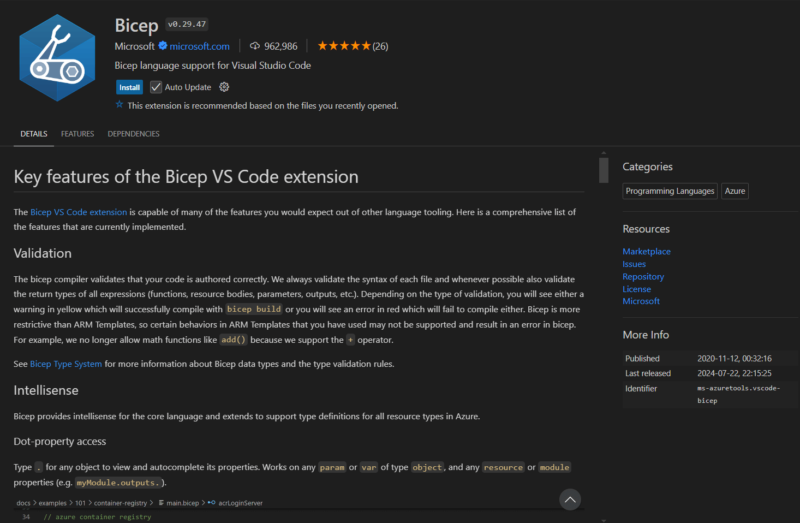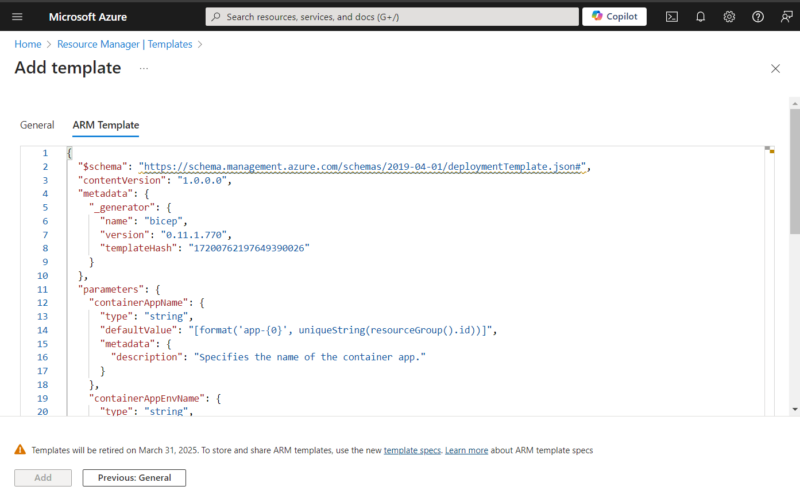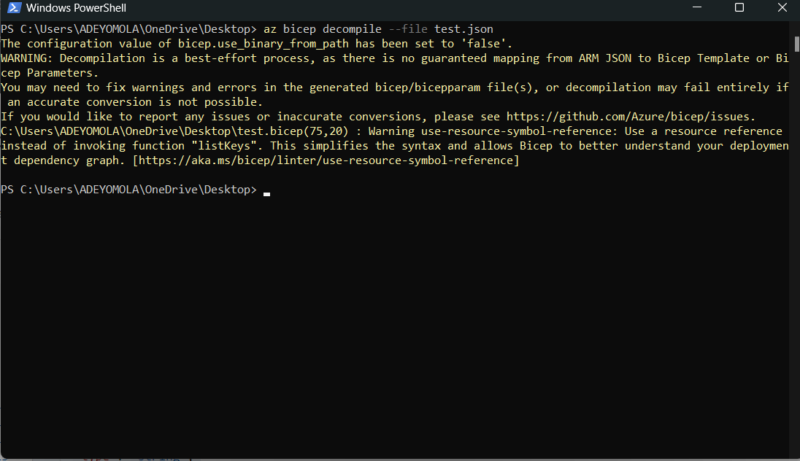Azure Resource Manager (ARM) is an infrastructure-as-code tool that not only manages and visualizes resources deployed in Microsoft Azure but is also used to deploy Azure resources using ARM templates and Azure Bicep, a template language used in ARM. Both have declarative syntax, but how do Azure Bicep vs ARM stack up against each other?
Since ARM templates and Azure Bicep are declarative, they are generally less verbose than imperative deployment templates. Their parameters are also not prone to obsolescence like imperative templates are, so in most cases, you wouldn’t have to conduct heavy code modifications.
This face-off compares Azure Bicep vs ARM templates, citing their key differences and advantages.
What Is Azure Bicep?
Azure Bicep is a language used to create templates for declarative deployments in Azure Resource Manager (ARM). Azure Bicep is one of two ARM template languages, with the other being JSON.

and Cloud Shell.
Unlike imperative deployments carried out with scripting languages like Bash, Azure Bicep’s syntax doesn’t get too complex with larger infrastructure. That said, the scripting commands may become outdated over time, prompting a review of the deployment scripts. However, declarative deployment templates usually maintain their parameters.
What Are Azure ARM Templates?
Azure ARM templates are files that declaratively define the underlying infrastructure and configuration of Azure resources deployed in Azure Resource Manager. There are two types of ARM templates: JSON and Bicep. However, colloquially speaking, ARM templates refer to JSON templates.

Azure ARM templates ensure consistency over multiple environments. For instance, you can deploy Azure resources in a test environment and in a production environment and get the same results. They also promote resource modularity, integrate with scripts, allow ordered deployments and preview infrastructural changes before applying them.
What Are the Key Differences Between Azure Bicep and ARM Templates?
Azure Bicep is one of two languages used to create ARM templates. ARM templates are the files containing the definition of a resource, written with Azure Bicep or JSON. When people refer to Azure ARM templates, they often mean JSON ARM templates. To clarify, let’s go over the key differences between Azure Bicep ARM templates and JSON ARM templates:
- Value combination: JSON ARM templates generally use concatenation to combine values. However, Azure Bicep templates achieve the same goal using string interpolation.
- Verbosity: Azure Bicep ARM templates are generally less verbose than JSON ARM templates. In fact, Azure Bicep templates can be shorter than an equivalent JSON ARM template by almost half. The difference in verbosity contributes to Azure Bicep’s relatively simpler syntax.
- Typing: Azure Bicep has built-in type checking, so you do not have to explicitly declare types when retrieving variables. However, you do have to declare types when retrieving variables in a JSON template.
- Modularity: Azure Bicep templates are more modular than JSON ARM templates. In other words, Bicep code is not too intertwined to separate into sections for different resources. The sections of JSON ARM templates, on the other hand, are generally more interdependent, limiting modularity.
- Logical operators: Azure Bicep uses logical operator symbols such as “?” and “&&,” whereas JSON ARM templates use their non-symbolic equivalents — “if,” “and,” “or” and so on.
- Dependency: Azure Bicep allows you to set explicit and implicit dependencies, while JSON uses only explicit dependencies.
What Are the Advantages of Azure Bicep Over ARM Template?
Azure Bicep syntax is generally simpler than an ARM template’s JSON syntax. Azure Bicep is shorter, easier to read, easier to understand and more maintainable. Therefore, it is better suited for larger infrastructures and resources.
You can readily modularize and reuse Bicep templates, but this is not always as easy with JSON ARM templates. In addition, thanks to its simplicity, Azure Bicep does not require previous experience. However, previous knowledge of JSON would come in handy with JSON ARM templates.
What Are the Advantages of Azure ARM Template Over Azure Bicep?
The primary advantage of using an Azure ARM template over Azure Bicep is flexibility. Azure Bicep is limited to use in Azure Resource Manager (ARM), whereas JSON ARM templates are usable in various contexts. In fact, Azure Bicep code is converted to JSON ARM templates before being used in Azure Resource Manager.
Why does ARM convert Bicep to JSON ARM templates? ARM has to communicate with other services to deploy resources, and JSON is a better way to communicate since it is more versatile. In addition, because they’ve been around longer, JSON ARM templates are more compatible with existing ARM templates and legacy systems.
How to Migrate From Azure ARM to Bicep
To migrate — or, more accurately, decompile — ARM templates to Bicep, you need the Bicep command line tool. There are various ways to install this tool. However, if the Azure CLI is already installed, Bicep will install automatically when you run a command that needs it.
Once the Bicep CLI is installed, follow these steps to migrate an Azure ARM JSON template to Bicep.
Final Thoughts
Compared to imperative deployments, Azure Bicep and JSON ARM templates are simpler and remain consistent over time. However, between Azure Bicep and ARM templates, Azure Bicep is much simpler, less verbose, more readable and more maintainable.
What has your experience been like with infrastructure-as-code tools? Which advantages do you think Azure Resource Manager has over alternatives? Would you stick with JSON ARM templates over Azure Bicep? Tell us why in the comments below. Thank you for reading.
FAQ: Azure ARM vs Azure Bicep
-
ARM is an abbreviation for Azure Resource Manager, an infrastructure-as-code tool in Microsoft Azure, while Azure Bicep is a template language used in ARM.
-
Azure Bicep is a template language used to write declarative deployment files in Azure Resource Manager. It is a domain-specific language (DSL), so you can use it only in Azure Resource Manager.
-
Azure Arc allows for the extension of Azure resources beyond the Azure cloud and also expands Azure management capabilities into hybrid and multi-cloud environments. On the other hand, ARM is an infrastructure-as-code (IAC) tool that manages the definition and deployment of resources within an Azure account.
-
Azure Blueprint and ARM both manage resources in the Azure cloud, but Azure Blueprint focuses on resources for environment setup, such as policies, roles and resource groups. Though ARM templates can also deploy some of these resources, it doesn’t actively remain in sync with the deployed resources the way Azure Blueprint does.
The post Azure Bicep vs ARM Templates: Key Differences appeared first on Cloudwards.


